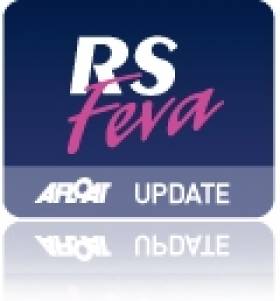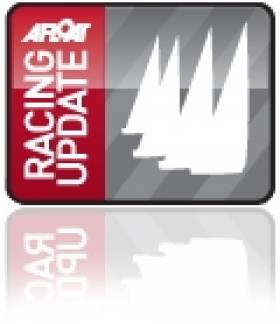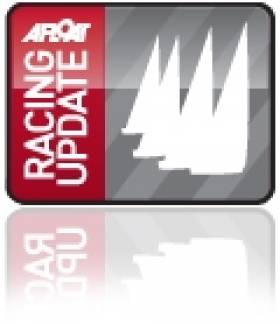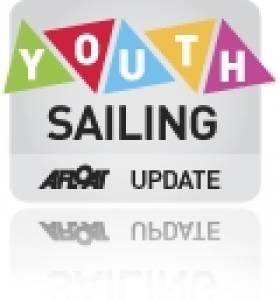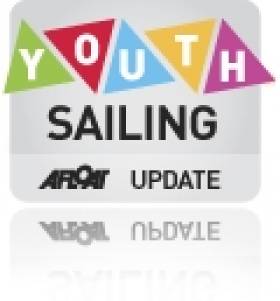Displaying items by tag: Feva
Racing Update: World Team Racing, Lasers, Fevas, Fireballs, DBSC, Cruiser Challenge
All the weekend sailing news is wrapped up in a number of posts on Afloat.ie this morning: Schull Welcomes World Team Racers, Espey Wins Lasers, Local Sailor Takes Radials at Lough Derg Nationals, Howth Juniors Win 19-Boat Greystones Feva Event, Royal Cork Celebrates 2011 with 'At Home' Regatta, Supernova to the Fore in DBSC Cruiser Challenge Event, McCartin and Kinsella are New Irish Fireball Champions, Kenefick Steers Chimp to Overall Win at Half Ton Classic Cup, Cork Week Changes Dates for 2012.
Sign up for our newletter coming later this morning!
Howth Juniors Win 19-Boat Greystones Feva Event
Seven races were sailed and Howth visitors David Johnston and Louise Flynn Byrne emerged clear winners from Dun Laoghaire's Stephen Judge and Patrick Riordan by a margin of 12 points. Full results here.
Avoiding a Capsize to Windward
We had great reaction to the dramatic 'windward capsize' picture from last weekend's Feva national championships on our home page.
Afloat Photographer Bob Bateman (who else?) was on the Curlane Bank in Cork Harbour to capture the windward capsize of plucky youngsters Grattan Roberts /James McCarthy who finished eighth in the 30-boat regatta. Here's the full sequence of that windward capsize...
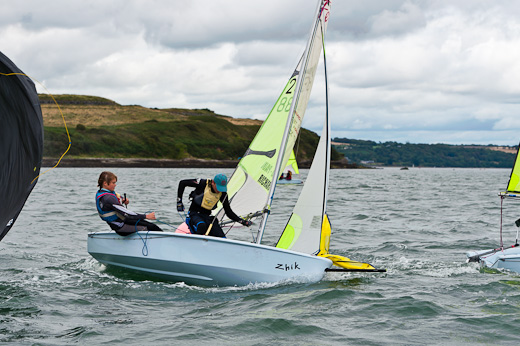
Approaching the weather mark. The helmsman bears off for the important rounding and the crew moves inboard for the spinnaker hoist...
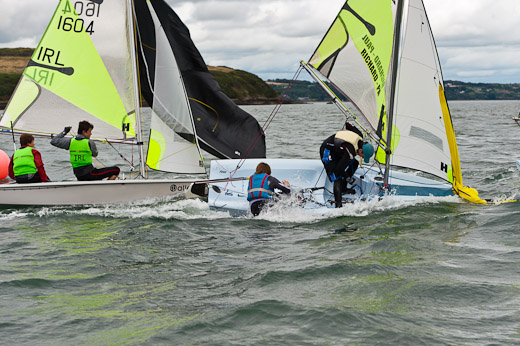

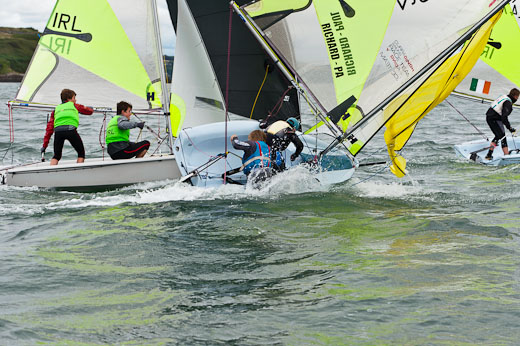
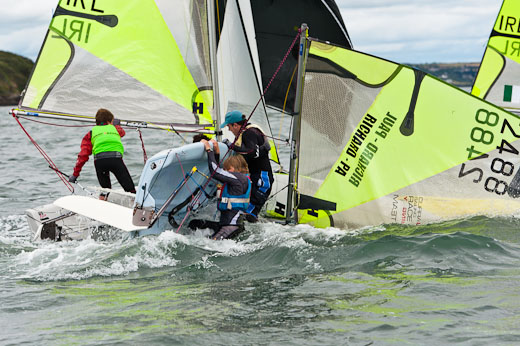

To avoid this, it's an idea to ease off the kicker to a marked position so as to keep the leech closed.
It's worth remembering too that in big breezes you need to ease and gently bear away with correct twist in the main to stop a capsize to leeward!
Centreboard position also plays a part. Too little centreboard down can result in a broach to weather whereas too much centreboard down in a bear away can result in capsize to leeward.
Racing Round up: Olympic, Fastnet, Clipper, Figaro, Dragon, J24, Fifteen, Topper, Feva, Oppy
This morning's edition includes photos and pics from Sunday's Figaro departure from Dun Laoghaire and the Rick Tomlinson's pics of the start of the Fastnet race from Cowes. Derry-Londonderry is on her way to Rio in the Clipper race. Regrettably there was no Gold, Silver or Bronze from Weymouth but we're in a strong position. See our video with Annalise here. Plus: The Topper Worlds at the National YC, John Lavery's win at the Flying fifteen South coast champs in Dunmore East, the J24 Nationals from Lough Erne, A local pair whitewashed the RS Feva Nationals in Cork Harbour, some great shots from Bob Bateman. The Oppy Nationals start in Howth and Afloat's Sailor of the Month for July Martin Byrne retained the Dragon Nationals in Kinsale. There's also the full weekend results from Dublin Bay SC.
Sign up and We'll Send You This Weekend's Irish Sailing News
Monday's edition includes photos and pics from Sunday's Figaro departure from Dun Laoghaire and the start of the Fastnet race from Cowes. Will it be Gold, Silver or Bronze from Weymouth? How will Peter, David and Annalise end up at the Pre-Olympics? Plus: The Topper Worlds at the National YC, Flying fifteen South coast champs in Dunmore East, the J24 Nationals from Lough Erne, Teens battle for the RS Feva Nationals in Cork Harbour, the Cove People's Regatta, The Oppy Nationals at Howth and the Dragon Nationals from Kinsale. There's also the full results from Dublin Bay SC and Howth.
Don't miss your free newsletter. Sign up here.
300 Top Junior Sailors Bound for Dublin Bay
Over 300 sailors will compete in Dublin Bay in seven different classes (Laser Radial, Laser 4.7, 420, Feva, Topper, SL16 and Optimist). For youth sailors, this event is the most important in the annual calendar as it is the decider for the top Irish sailors to compete internationally during 2011 and is the pathway for future Olympic sailors. Podcast with Olympic Team Manager James O'Callaghan here.
The 420 fleet is already in situ as the Leinster Championships were held over Easter and the girls team Emma Geary and Niamh Connolly won the event in style. This team is the only 420 crew to qualify internationally for a place on the Irish team to compete in the ISAF Youth Worlds in Zadar, Croatia and will be looking to win next weekend to secure this honour.
Dublin Bay will host the 2012 ISAF Youth World Championships and this year's ISA Mitsubishi Youth National event is an important test event with representatives from the international sailing authority visiting Dun Laoghaire to view plans and test logistics.
In addition to the 420 fleet the Laser radial fleet will also be competing to qualify to represent Ireland in Croatia. Philip Doran aged 17 from Courtown in Wexford is the current former under 17 World Champion in the Laser Radial fleet although the National title has eluded him so far. In the girls fleet it will be a toss up between Saskia Tidey (RIYC) and Sophie Murphy (Quoile YC) as both already have a national title each under their belts.

A fleet of top Optimists are expected. Photo: Bob Bateman
The younger Optimist fleet is also celebrating this week after two top 5 positions at the Easter Regatta in Braassemermeer, the Netherlands. In fact an Irish team has competed at this event for 23 years and this is the first time that Ireland has won the country prize. Sean Donnelly from Dun Laoghaire who finished fourth in Braassemermeer is also leading the Optimist fleet in the trials and will be anxious to hold on to first position during the ISA Mitsubishi Youth Nationals.
In other fleets, the laser 4.7 fleet is enjoying record numbers with many ex-Optimist and Topper sailors choosing this boat. Finn Lynch from Blessington and Seafra Guilfoyle from Cork will be firm favourites to win the class.
Overall Dublin Bay will be a spectacle of sail over the May Bank holiday weekend with light winds forecast.
Mitsubishi Motors have been a proud supporter of junior sailing in Ireland for the last 7 years. In recent years Ireland has had successes at youth level with winner of the girls under 21 Laser World Championships and a top 10 at the 2010 ISAF Youth Worlds and wins at the British National Optimist Championships.
RS Feva Sailing Dinghy Launches in Malta
Paul Childs, a qualified instructor from RS Sailing, visited Malta to run an initial coaching weekend, helping to set up the boats and introduce the young sailors to Feva sailing techniques. "As usual, the kids were really excited about the Fevas and they had a brilliant time on their first weekend" he reports. "Some of them are clearly already talented young sailors and I reckon we'll see some of them heading towards the top of the class pretty quickly. But the main thing is... they all had fun."
Adoption of the RS Feva class means Malta follows the pathway adopted by an ever increasing number of nations. The Feva can be used for training as well as racing, with the rotomoulded polyethylene construction system giving a durable and affordable boat. Young sailors are attracted by the performance, modern style and asymmetric spinnaker.
The 2011 RS Feva World championships, sponsored by Allen Performance Hardware and Magic Marine, take place in Holland in late July with entries expected to exceed last years 150 boat fleet from as far afield as Hong Kong.
You can find out more information about the growth of the RS Feva class in Malta by contacting Birzebbuga Sailing Club – www.birzebbugasailing.com and full details of the RS Feva can be found at www.RSsailing.com or the International Class Association at www.RSsailing.org .
Craftinsure Sponsor Royal St. George Junior Event
Dun Laoghaire's Royal St. George Yacht Club has announced that its inaugural Junior Spring Open, sponsored by Craftinsure, will be held on the 19th & 20th of March 2011. This event promises to be a great kick start to the Junior Sailing Season for the Optimist, 420, Feva and Laser Classes.
There will be both Regatta and Main Fleets, Regatta Coaches on the courses and the event will count as an Optimist Pre-Trials and Pre-Regional event. With the ISA Mitsubishi Youth National Championship being held in the same sailing area at the end of April, this event is a great opportunity for sailors from all around the country to get some practise in the local waters.
There will be entertainment for sailors and parents on both evenings, evening dinners and, of course, full Six Nations Rugby coverage on the Saturday throughout the Club. There will also be live-tweeting from the water throughout the event - follow this live action unfold at www.twitter.com/rsgyc.
For further information and to enter online please visit www.rsgyc.ie. The Entrance Fee is €85 for Fevas & 420s and €55 for Oppies & Lasers.
Bank Holiday Youth Champs to Expect 300
May Bank Holiday weekend (29 April – 02 May) over 300 sailors will compete in Dublin Bay in seven different classes (Laser Radial, Laser 4.7, 420, Feva, Topper, SL16 and Optimist). For youth sailors, this event is the most crucial in the annual calendar as it is the decider for the top Irish sailors to compete internationally during 2011 and is the pathway for future Olympic sailors.
Not only will the ISA Mitsubishi Youth Nationals over the May weekend be an important event for youth sailors it is also a major milestone for the organisers of the ISAF Youth Worlds 2012 as it offers them the opportunity to test drive the logistics of managing such a large event incorporating three clubs, three race courses and hundreds of volunteers.
'Dun Laoghaire has a proud reputation for hosting international events such as the biennial combined clubs Dun Laoghaire Regatta and numerous world championships. However in 2011 the ISA Mitsubishi Youth Nationals is of more significance as it gives us an opportunity to test our systems in advance of the ISAF Youth Worlds 2012.' stated Event Chairman Brian Craig.
Dun Laoghaire won the bid to host the ISAF Youth Worlds 2012 from 12-21 July when, in excess of 300 sailors and windsurfing champions from over 60 nations will participate. The granting of this prestigious sailing event to Ireland is a major boost to the sport and secures Ireland's position as an ideal location for hosting world class sailing events. It also establishes Dun Laoghaire as one of the prime major racing locations in the world, capable of running multiple classes and courses to the highest international standard.
'The Youth Nationals is a significant event on the racing calendar. It involves young sailors from all of the 'Olympic Pathway' classes, some of whom are competing for places on the team that will represent Ireland in the ISAF Youth Worlds later this year. In recent years Ireland has had successes at youth level with winner of the girls Laser World Championships a top 10 at the 2010 ISAF Youth Worlds and wins at the British National Optimist Championships.
Three hundred sailors from around the country are expected to compete for national youth and junior pathway titles and the Mitsubishi coaching grant during the event.




























